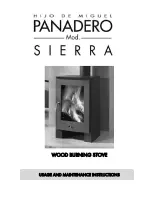
220206-20
SUPER-SD1
11
Ash Removal
Caution: Ashes are to be removed only when the heater is cold.
Whenever ashes get 3 to 4 inches deep in your firebox, and
when fire has burned down and cooled, remove excess ashes.
Leave an ash bed approximately 1" (25 mm) deep on the
firebox bottom to help maintain a hot charcoal bed.
Optional Ash Cleanout system:
The ash dump handle is
located under the ash lip on the left hand side. To operate ash
dump, pull handle out 1/2" and turn clockwise. This will unlock
the ash dump and allow it to open. Hold handle open while
pulling ashes into the opening. Avoid large embers as these still
contain heat value. Release handle and push in to lock. Ensure
ash dump door is properly engaged. Fill the cavity with the
remaining ash level with the firebox floor. Lift and pull out
ashpan and discard ashes into metal container. Replace ashpan
and ensure it is seated properly.
Do not burn with ash dump door open. Doing so will create
a hazardous condition. Always leave about 1" of ash when
cleaning.
Disposal of Ashes
Ashes should be placed in a metal container with a tight fitting
lid. The closed container of ashes should be placed on a non-
combustible floor or on the ground, well away from all combus-
tible materials, pending final disposal. If the ashes are disposed
of by burial in soil or otherwise locally dispersed, they should
be retained in closed container until all cinders have thoroughly
cooled. Other waste should not be placed in this container.
Baffle Removal
Chimney connector pipe should be disconnected from stove to
clean and inspect. Only if this is not possible should you
remove baffle assembly.
DO NOT OPERATE WITH BAFFLE ASSEMBLY OR
INSULATION REMOVED.
Removal
Remove retaining pin at the back top of the firebox, just under
the baffle. Lift baffle up and pull forward to disconnect from
the supply tube. Tilt baffle sideways to drop down and remove
from firebox. Inspect gasket between baffle and supply tube.
If necessary, replace with gasket #139.5 available from your
Pacific Energy dealer. Re-install baffle assembly in reverse
order. The two side pieces of insulation must be tight against
the siderails.
Restarting After Extended or Overnight
Burns
1. Open door and rake hot embers towards the front of the
heater. Add a couple of dry, split logs on top of embers,
close door.
2. Adjust air control to high and in just a few minutes, logs
should begin burning.
3. After wood has charred, reset air control to desired setting.
4. To achieve maximum firing rate, set control to high "H". Do
not use this setting other than for starting or preheating
fresh fuel loads.
DO NOT OVERFIRE THIS HEATER: Attempts to achieve
heat output rates that exceed heater design specifications
can result in permanent damage to the heater and chimney.
More Wood, More Heat
Seasoned wood has approximately 7500 BTU's per pound. If
you put 10 pounds of wood in your stove for an eight hour burn
the wood will be producing 9375 BTU's per hour. (7500 BTU
x 10 lbs./8hrs.=9375 BTU's per hr.) If you put 20 lbs of wood
in your stove for eight hour burn you will get 18,750 BTU's per
hr. (7500 BTU x 20lbs./8hr.=18,750 BTU's per hr.). This is
only an example and is based on 100% efficiency. In reality,
your stove should perform in the 70% efficiency range.
Experience will give you the right settings for proper combus-
tion and efficient burning. Remember the correct air inlet
setting is affected by variables such as type of wood, outside
temperature, chimney size and weather conditions. With
practice, you will become proficient in operating your heater
and will obtain the performance for which it was designed.
Proper Draft
1. Draft is the force which moves air from the appliance up
through the chimney. The amount of draft in your chimney
depends on the length of the chimney, local geography,
nearby obstructions and other factors.
2. Too much draft may cause excessive temperatures in the
appliance. An uncontrollable burn or a glowing red stove
part or chimney indicates excessive draft.
3. Inadequate draft may cause backpuffing into the room and
plugging of the chimney. Smoke leaking into the room
through appliance and chimney connector joints indicates
inadequate draft.






































